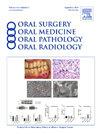Goldenhar syndrome: report of rare findings in the cervical spine, coronoid process, and temporal bone
IF 2
3区 医学
Q2 DENTISTRY, ORAL SURGERY & MEDICINE
Oral Surgery Oral Medicine Oral Pathology Oral Radiology
Pub Date : 2025-02-04
DOI:10.1016/j.oooo.2024.11.016
引用次数: 0
Abstract
Introduction
Goldenhar syndrome is a rare developmental condition considered by some to be a variant of hemifacial microsomia. In 1991, Vento et al. described the O.M.E.N.S. classification for hemifacial microsomia (HM), further supporting the consideration of Goldenhar syndrome as an HM subtype as the result of effects on the orbit, mandible, ear, facial nerve, and soft tissues.
Clinical Presentation
This report presents the case of a 16-year-old female patient diagnosed with Goldenhar syndrome shortly after birth. Anonymized findings from recent cone beam computed tomography will be presented in addition to those of multidetector computed tomography acquired over the course of surgical management. Key findings include unilateral coronoid hyperplasia of the unaffected side, pseudo-joint formation from the left transverse process of C1 to the occipital condyle, and proliferation of the temporal bone with an appearance suggestive of fibro-osseous disease.
Differential Diagnosis
Anomalies of the coronoid process and cervical spine are likely accounted for by the patient's diagnosed developmental anomaly. A case with a similar presentation of the coronoid process could not be found in the literature, whereas the patient's vertebral anomalies are not dissimilar to a limited number of cases reported in 2017 by Renkema et al. Fibrous dysplasia may account for the presentation of the patient's temporal bone on the affected side.
Diagnosis and Management
Surgical procedures pursued to address the patient's diagnosed condition included multiple rib grafts, distraction osteogenesis, surgeries to address microtia on the affected side, an inverted L-osteotomy, and open reduction with internal fixation.
Conclusion
This case represents a unique combination of vertebral, mandibular, and temporal bone anomalies yet to be reported in the literature.
求助全文
约1分钟内获得全文
求助全文
来源期刊

Oral Surgery Oral Medicine Oral Pathology Oral Radiology
DENTISTRY, ORAL SURGERY & MEDICINE-
CiteScore
3.80
自引率
6.90%
发文量
1217
审稿时长
2-4 weeks
期刊介绍:
Oral Surgery, Oral Medicine, Oral Pathology and Oral Radiology is required reading for anyone in the fields of oral surgery, oral medicine, oral pathology, oral radiology or advanced general practice dentistry. It is the only major dental journal that provides a practical and complete overview of the medical and surgical techniques of dental practice in four areas. Topics covered include such current issues as dental implants, treatment of HIV-infected patients, and evaluation and treatment of TMJ disorders. The official publication for nine societies, the Journal is recommended for initial purchase in the Brandon Hill study, Selected List of Books and Journals for the Small Medical Library.
 求助内容:
求助内容: 应助结果提醒方式:
应助结果提醒方式:


